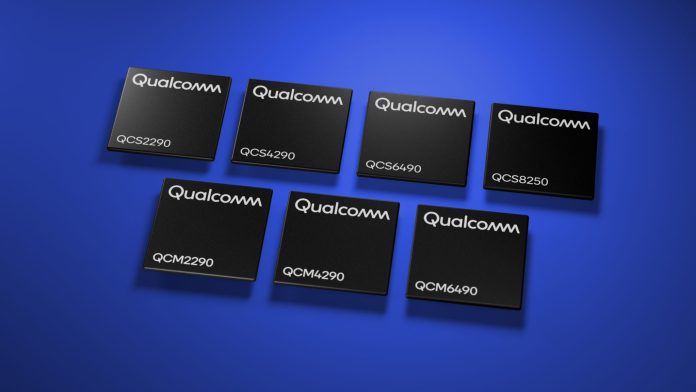Qualcomm has released a glut of IoT solutions, variously offering Wi-Fi and 5G connectivity for enterprise and industrial IoT applications. The firm, compelled by rising demand for higher-grade IoT units as a consequence in part of changing Covid-era work practices across, has released seven solutions in one go. It said the new releases, mostly available now, will drive digital change in industry.
The new products include the premium-level QCS8250 application processor with integrated Wi-Fi 6 connectivity, with an option for enterprises and manufacturers to incorporate 5G modules into the bargain as well, including in tandem with the just-released 315 5G IoT modem. The other six are ranged across high, mid, and low tiers, with a QCS application processor and QCM module variant pitched into each segment.
The QCS range, like the top-level QCS8250, integrates Wi-Fi onto the application processor, with the option to plug cellular modules in separately. The QCM range all offer integrated 5G, alongside Wi-Fi, as well as sundry short-range connectivity options. The 5G modules feature Release 15-level capabilities; the firm said Release 16 and 17 5G units, to replace industrial ethernet in Industry 4.0, remain in development.
Qualcomm said, effectively, the new solutions are geared at bringing industrial-grade connectivity into crossover enterprises sectors, notably warehousing, logistics, transportation, and retail. More exacting Industry 4.0-style capabilities will come later, it noted. Crucially, the solutions, built around IoT-geared application processors, bring important computing and analytics functions to enterprises.
They all leverage Qualcomm’s Kryo CPU architecture and AI Engine, and are variously pegged to handle compute-intensive edge workloads, notably from camera applications in various industrial, warehousing, retail, and office environments. The naming system makes room for new entries, the firm suggested, including later-generation Release 16 and 17 5G-capable units.
The premium-level QCS8250, based on the Kryo 585 architecture, features an image signal processor for up to seven concurrent 4K cameras running at 120 frames per second. It includes a new neural processing unit (NPU) for “max performance” edge analytics and machine learning. Qualcomm cited “purpose-built” smart camera and video collaboration applications in healthcare and retail.
The QCS8250 was in the offing; the others have been accelerated, to an extent, to meet demand in the market, Qualcomm suggested. The twin QCS/QCM6490 solutions, also pitched at the higher end, also based on the Kryo 585, are the company’s “first optimized IoT solutions built to deliver premium-tier features”, it said.
They support, in their respective processor and module arrangements, Wi-Fi 6E and sub-6 GHz mmWave 5G, and are pitched for “ruggedized handhelds and tablets, industrial scanners, and human machine interface systems” in sundry asset management applications. Unlike the other releases, which are all available now, the 6490 solutions will be available in Q3.
The mid-level QCS/QCM4290, based on the Kryo260 architecture, in one form or another, support Wi-Fi 6 (ready) and LTE (Cat13) connectivity. The entry-level QCS/QCM2290 solutions run on the Cortex A53 CPU architecture, are designed for “retail point-of-sale, industrial handheld, tracking, and camera applications,” said Qualcomm.
Jeff Lorbeck, senior vice president and general manager of connected smart systems at Qualcomm, commented: “Qualcomm is uniquely positioned to lead the IoT ecosystem forward with our systems-level approach. These new IoT solutions further exemplify our commitment to driving global digital transformation and providing a portfolio of solutions to transform industrial and enterprise IoT applications to achieve cutting edge performance and seamless connectivity.”

